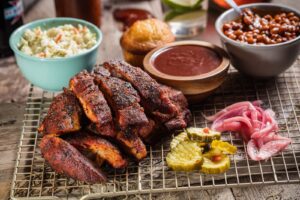Man, I could go for some good BBQ

Here are the keys to make it GREAT!
Quality Ingredients: Start with high-quality meats. For example, choose well-marbled cuts of pork for pulled pork or ribs, and choose beef brisket with a good fat cap for smoked brisket.
Proper Seasoning: Use a good dry rub or marinade to season the meat before cooking. The seasoning should complement the flavor of the meat without overpowering it.
Low and Slow Cooking: Barbecue is traditionally cooked low and slow over indirect heat. This slow cooking process allows the meat to become tender and develop complex flavors. Maintain a consistent temperature throughout the cooking process.
Smoke: Wood smoke is a key component of barbecue flavor. Use hardwoods like hickory, mesquite, oak, or fruit woods like apple or cherry to impart flavor to the meat. Experiment with different wood combinations to find the flavor profile you prefer.
Moisture Management: Barbecue meats can dry out during the long cooking process. Use a water pan or mop sauce to keep the meat moist and prevent it from drying out.
Patience: Good barbecue takes time. Don’t rush the cooking process. Plan ahead and allow plenty of time for the meat to cook low and slow until it’s tender and flavorful.
Resting: Allow the cooked meat to rest before serving. This allows the juices to redistribute throughout the meat, resulting in a juicier end product.
Sauce (optional): While some barbecue purists prefer their meat without sauce, a good barbecue sauce can enhance the flavor of the meat. Experiment with homemade or store-bought sauces to find one that complements your barbecue.
Practice and Experimentation: Barbecue is as much an art as it is a science. Don’t be afraid to experiment with different techniques, seasonings, and cooking methods to find what works best for you.
By paying attention to these key aspects, you can consistently produce delicious barbecue that will have your friends and family coming back for more.